Cloud Computing Market Size
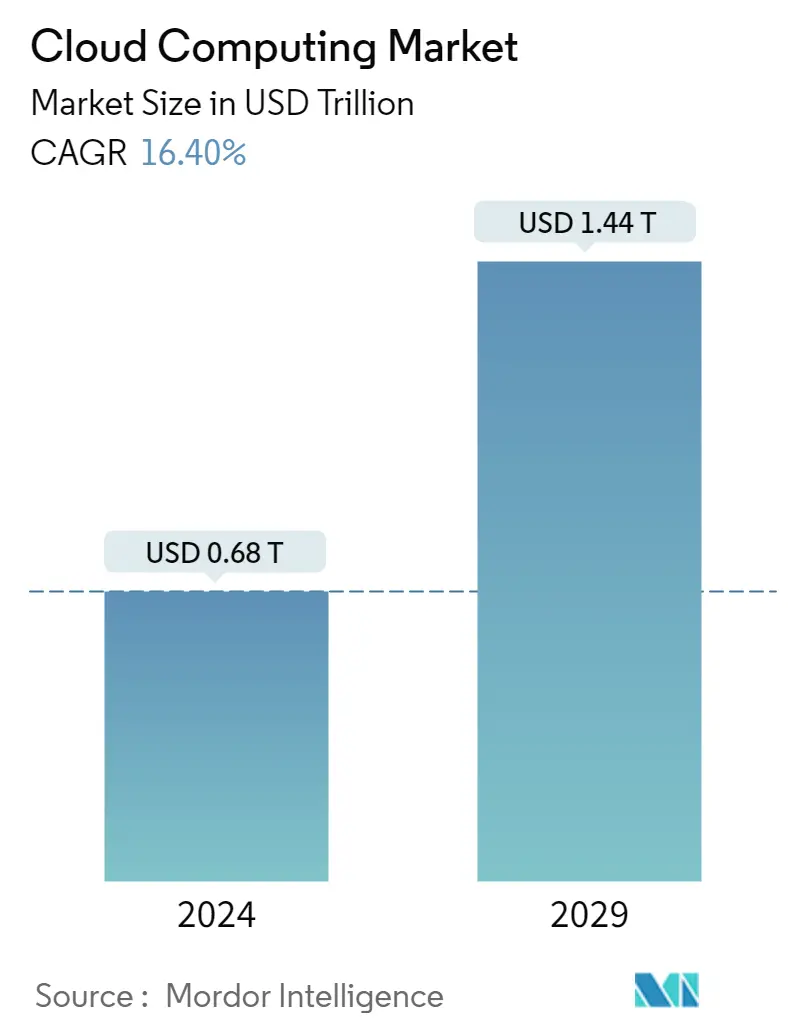
| Study Period | 2019 - 2029 |
| Market Size (2024) | USD 0.68 Trillion |
| Market Size (2029) | USD 1.44 Trillion |
| CAGR (2024 - 2029) | 16.40 % |
| Fastest Growing Market | Asia-Pacific |
| Largest Market | North America |
Major Players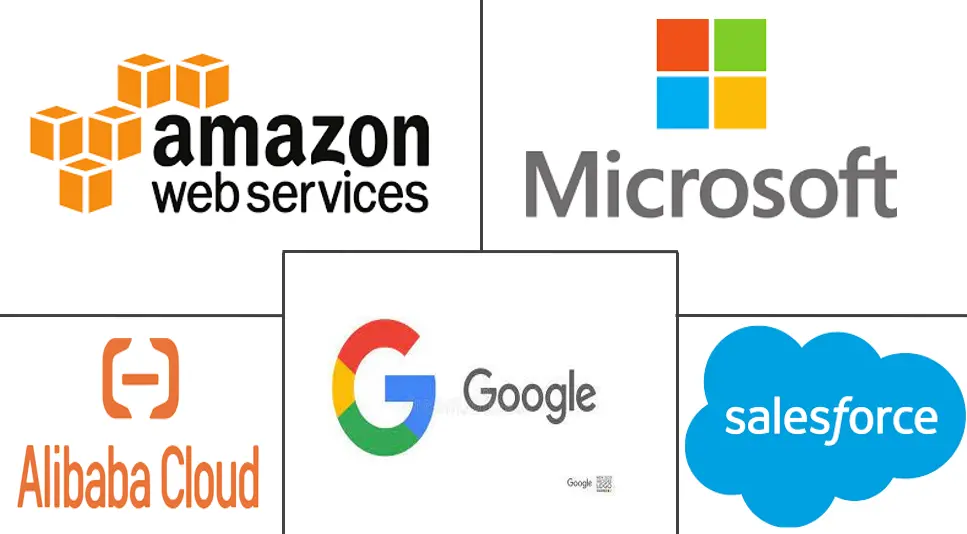
*Disclaimer: Major Players sorted in no particular order |
Need a report that reflects how COVID-19 has impacted this market and its growth?
Cloud Computing Market Analysis
The Cloud Computing Market size is estimated at USD 0.68 trillion in 2024, and is expected to reach USD 1.44 trillion by 2029, growing at a CAGR of 16.40% during the forecast period (2024-2029).
Enterprise routers are essential products that are utilized on a daily basis by any business or enterprise. The global demand for cloud computing is growing due to emerging technologies like big data, AI, and machine learning (ML). Also, increased focus on customer-centric applications to boost consumer satisfaction is one element impacting the rise of emerging technologies.
- Cloud-based infrastructure provides flexible, on-demand access to the resources underlying these new digital business solutions. The technology is beneficial for enterprise resource planning (ERP), online transaction processing (OLTP), and supply chain management (SCM) across sectors. In November 2022, Amazon Web Services Inc. launched a supply chain management application that would eliminate the requirement for businesses to utilize multiple systems and vendors to access critical network data. AWS Supply Chain is a machine learning-powered application that automatically combines and analyzes data across numerous supply chain systems, creating a “unified data lake.”
- Companies are transforming towards implementing hybrid cloud in their business environment. Agility is the hybrid cloud's main advantage. Companies are integrating public, private, and on-premises resources to acquire agility and competitive advantage. To that extent, in May 2023, IBM unveiled IBM Hybrid Cloud Mesh, a SaaS offering that is developed to facilitate enterprises to obtain management to their hybrid multi-cloud infrastructure. Driven by “Application-Centric Connectivity,” IBM Hybrid Cloud Mesh is arranged to automate the process, management, and observability of application connectivity in public and private clouds to facilitate modern enterprises to operate their infrastructure across hybrid multi-cloud and heterogeneous environments.
- The market is also witnessing several investments that significantly drive the adoption of cloud computing. For instance, in May 2023, Amazon's cloud computing unit, Amazon Web Services, revealed its intention to invest USD 12.7 billion in cloud infrastructure in India by 2030. The aim is to meet the country's increasing demand for cloud services. According to AWS, the investment is anticipated to support an average of 131,700 full-time equivalent jobs yearly in Indian businesses. AWS assesses that its overall contribution to India's gross domestic product from 2016 to 2022 surpassed approximately USD 4.6 billion.
- Organizations increasingly need solutions that enable employees to operate remotely safely and productively. To enable remote work for normal employees, contact center agents, and creative professionals, providers offer specialized solutions based on their clouds in a secure, timely, and affordable manner. However, cloud computing is a technology that provides platforms, software, and infrastructure on demand, making it prone to various kinds of data breaches. If customers are certain that security measures are in place, they will raise security concerns about outsourcing their data to public cloud services. Although cloud service providers work hard to protect their client's data, there have been several data breach events to cause problems for even the most well-known businesses. For instance, according to Verizon, in 2022, there were 1,829 reported cyber incidents in the financial industry worldwide.
- Further, macroeconomic trends have a significant impact on the cloud computing market. The rising inflationary pressure is likely to increase the costs of professional services for companies operating on cloud environment. For instance, according to OECD, the annual monthly inflation rate in the Organization for Economic Co-Operation and Development (OECD) increased steadily from February 2021 to October 2022, when the inflation rate reached 10.7% compared to the same month the previous year.
Cloud Computing Market Trends
Business Integration with Cloud Boosting Digitalization Across Industries
- In this new digital era, companies are aiming to become agile with the integration of new technologies. This is mainly accomplished by moving to a cloud environment. Being in the cloud entails obtaining embedded connections and intelligence, enabling the interoperability of smart operations, and developing a solid foundation for digital services linked to the cloud.
- Digital transformation is given an extra dimension by cloud computing, which transforms it from simply adopting new technology to a complete rebuilding of processes, tools, and experiences in a remote, virtual environment. Cloud computing boosts security, enhances user experience, and protects documents from deterioration. Because of this, businesses are now incorporating cloud computing into their ecosystem, fueling the growth of the cloud computing market.
- In contrast to the outdated on-premises server model that relies on human operations, cloud computing offers enormous opportunities for automation. The Platform-as-a-Service model, Infrastructure-as-Code techniques, automatic backups, version control provisioning for workflows, and security control administration through user access are all made simpler by the cloud.
- Cloud computing has emerged as a game-changer for businesses looking to develop Supply Chain Management (SCM) swiftly and successfully. For instance, as part of a multi-year partnership started in June 2022, Google Cloud and Connecticut-based XPO Logistics will work together to enhance the movement of commodities throughout supply chains. XPO will utilize Google Cloud's data analytics, machine learning, and artificial intelligence (AI) capabilities to build quicker, more effective supply chains with improved visibility.
- Since the introduction of the technology, many banking and fintech organizations have gradually migrated to the cloud. Data generation and consumption are expanding quickly in the financial sector. The solution increases openness while granting consumers more control over auditing procedures and data. It offers a more scalable method of categorizing data. Also, a variety of healthcare-related functions, including telehealth and virtual care, medication adherence, drug anti-theft and counterfeiting measures, resource inefficiency, personal data privacy, and the uniformity of medical records, have a great deal to gain from the integration of cloud computing and healthcare.
- Several companies like Amazon, google, and Oracle are offer robust cloud infrastructure and services to cater to the evolving and complex requirements of consumers. For intstacne, according to Flexera Software, state of cloud report 2023, 75% of enterprise respondents indicated that they were adopting Microsoft Azure for public cloud usage. AWS, Microsoft Azure, and Google Cloud, also known as hyperscalers, are among the leading cloud computing platform providers worldwide.
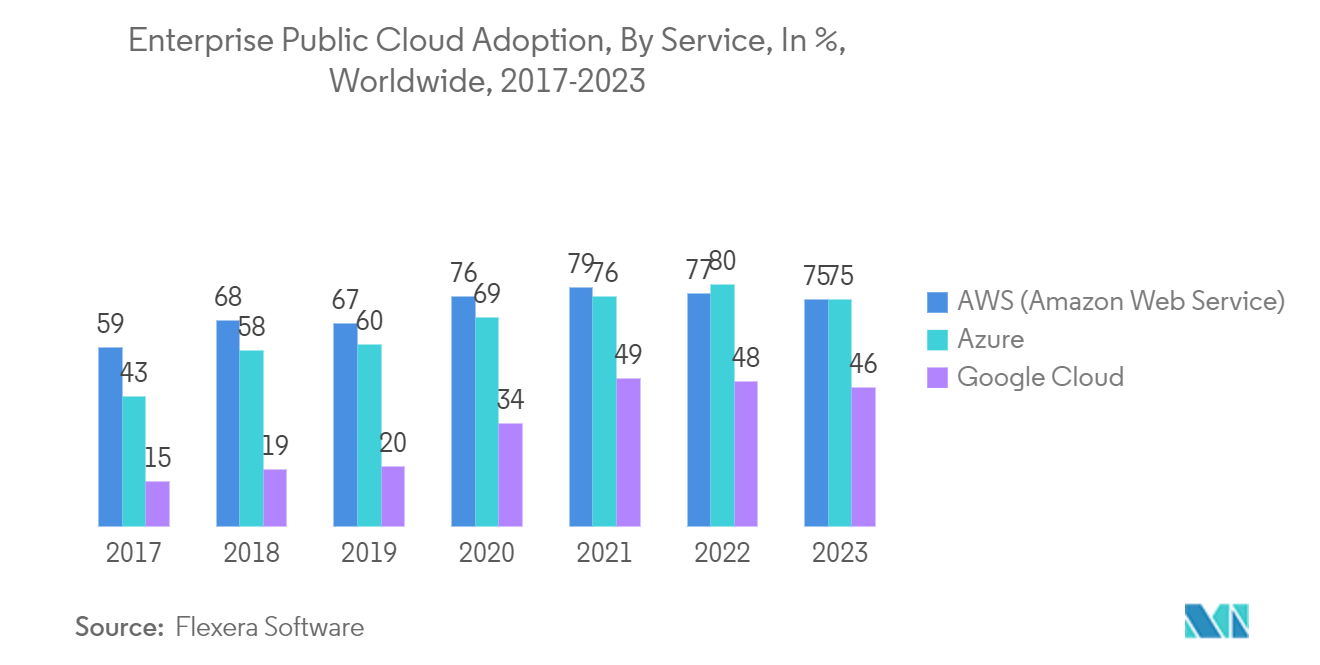
North America is Expected to Hold a Major Market Share
- Over the past few years, North America controlled the Cloud Computing Market. Companies in the U.S. prioritize digital transformation. They are often seen as early adopters of advanced technologies like the Internet of Things, additive manufacturing, big data analytics, connected industries, artificial intelligence, machine learning, virtual reality, and the newest telecommunications technologies like 4G, 5G, and LTE.
- The region is facing increasing data breaches in the recent years. For instance, according to Identity Theft Resource Center, in 2022, the number of data compromises in the United States totaled 1802 cases. Meanwhile, approximately 422 million individuals were affected in the same year by data compromises, including data breaches, exposure, and leakage. Such instances are likely to restrain the adoption of cloud computing in the region.
- The United States businesses are working together to grow their operations and maintain a strong global presence a strong presence in the global marketplace. Opportunities for the United States are predicted to increase due to organizations investing more in IT infrastructure and cloud services and the country's promotion of Cross Border Privacy Rules (CBPR).
- To provide better citizen services, government institutions are rethinking their economic models. According to the United States federal cloud computing strategy, the government implemented the CloudFirst policy to accelerate cloud adoption. Increased use of cloud services and edge computing is replacing the addition of infrastructure to data centers that are already overflowing with various platforms and vendors in U.S. government agencies of all sizes.
- The region is also witnessing several innovations that cater to the requirements of the technologically advanced consumers. For instance, in June 2023, Hewlett Packard Enterprise Co. announced that it is rolling out a cloud computing service designed to power artificial intelligence systems similar to ChatGPT. HPE's high-performance computing and artificial intelligence unit said the company would use its experience in supercomputers to offer a service specifically for what are called large language models, the technology behind services like ChatGPT.
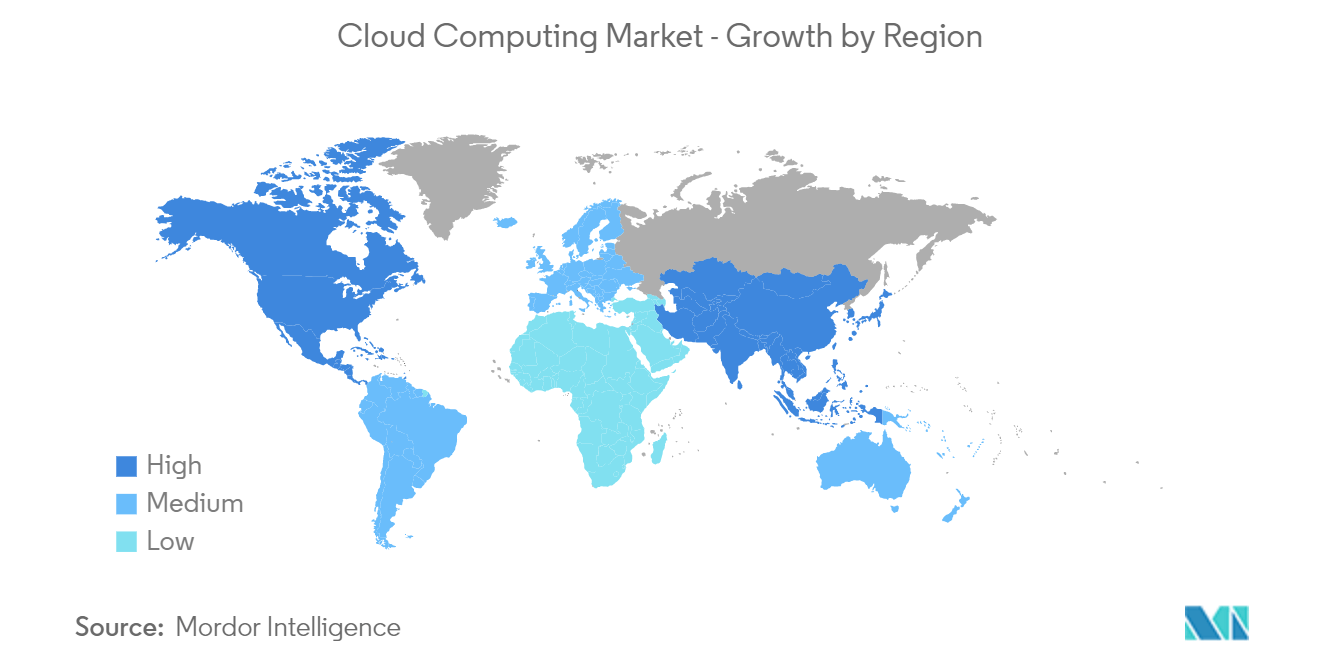
Cloud Computing Industry Overview
The Cloud Computing Market is at a highly fragmented stage as the market currently consists of many players. Several key players in the Cloud Computing market constantly try to bring advancements. A few prominent companies are entering into collaborations and expanding their footprint in developing regions to consolidate their positions in the market. The major player in this market includes Amazon Web Services, Inc, Google LLC, Ltd, Microsoft Corporation, Alibaba Cloud, Salesforce, Inc, and others.
- October 2022 - Oracle announced the creation of a new Oracle Interconnect for the Microsoft Azure site in Johannesburg, South Africa, to provide direct connectivity between the Oracle Cloud Johannesburg area and the Microsoft Azure South Africa region. African users can now access the Oracle Database Service for Microsoft Azure on the back of the most recent Oracle Interconnect.
- October 2022 - Google Cloud unveiled a variety of advancements, including fresh approaches and improvements for its open infrastructure cloud, data cloud, and Google Workspace. This aims to assist individuals within organizations - including data decision-makers, developers, builders, IT teams, cybersecurity experts, and all employees - in achieving practical, significant, and long-lasting transformation.
Cloud Computing Market Leaders
Amazon Web Services, Inc
Google LLC
Microsoft Corporation
Alibaba Cloud
Salesforce, Inc
*Disclaimer: Major Players sorted in no particular order
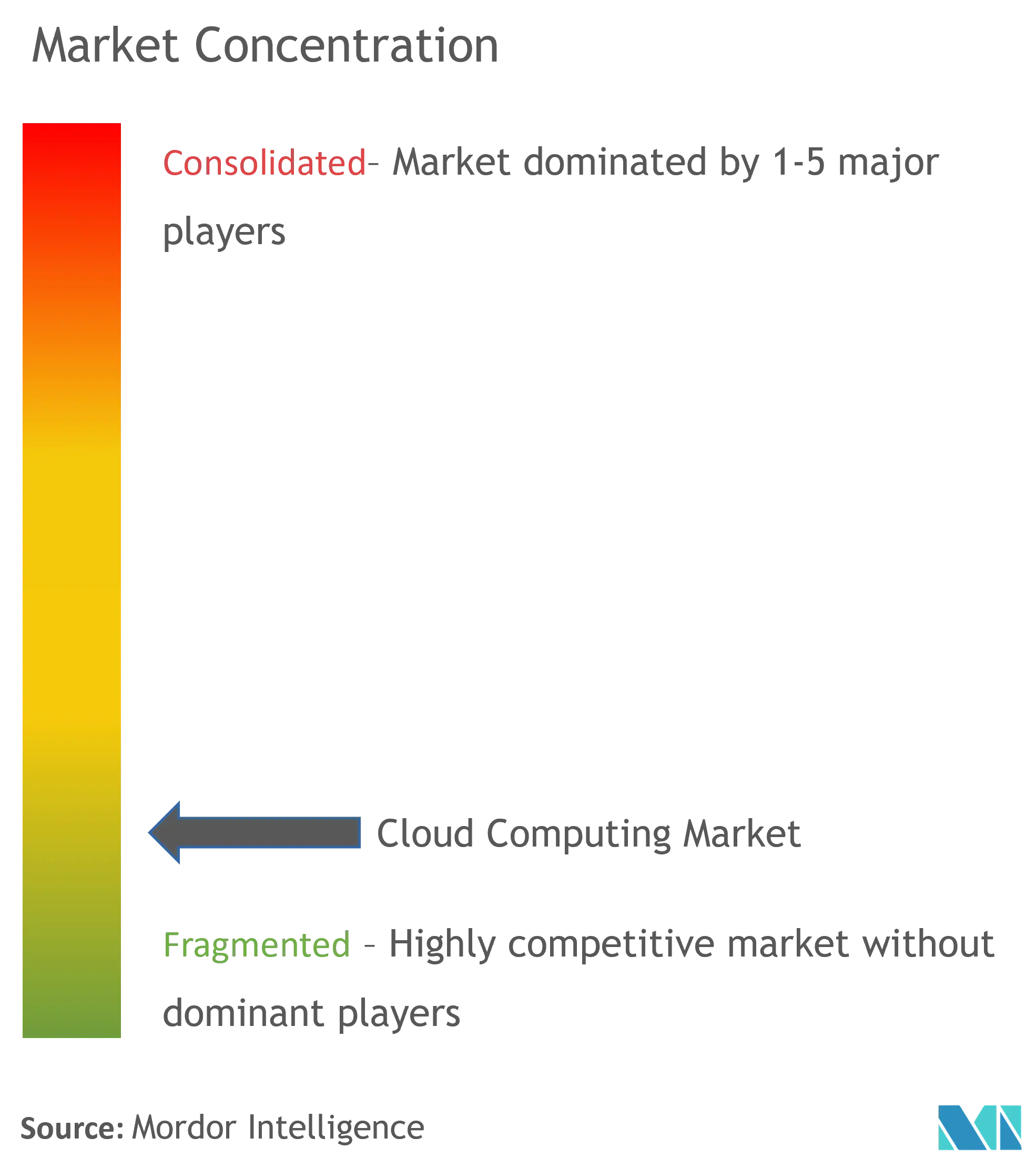
Cloud Computing Market News
- April 2023 - Alibaba Cloud unveiled cheaper options for its Elastic Compute Service and Object Storage Service and a large language model to keep pace with the demand for cloud services. The new ECS Universal is claimed to offer the same stability as ECS while reducing costs by up to 40%, and is suited for running web applications and websites, enterprise office applications, and offline data analysis. The OSS Reserved Capacity (OSS-RC) would let its customers reserve storage capacity in a specific cloud region for one year, reducing capacity cost by up to 50%.
- November 2022 - AWS opened India's Second Infrastructure Region. The second AWS Region enables Indian customers to have more alternatives to execute workloads with better resilience and availability, store data securely, and give end users even lower latency. By 2030, it is anticipated that the new AWS Asia Pacific (Hyderabad) region would provide more than 48,000 full-time employees annually, attributed to an investment of more than USD 4.4 billion in India.
Cloud Computing Market Report - Table of Contents
1. INTRODUCTION
1.1 Study Assumptions and Market Definition
1.2 Study Scope
2. RESEARCH METHODOLOGY
3. EXECUTIVE SUMMARY
4. MARKET DYNAMICS
4.1 Market Overview
4.2 Market Drivers
4.2.1 Robust Shift Towards Digital Transformation Across the World
4.2.2 Post- Pandemic Remote Work-Related Policies Positively Impacting the Cloud Market
4.3 Market Challenges
4.3.1 Regulatory Compliance and Data Breaching Risk
4.4 Market Opportunities
4.5 Industry Ecosystem Analysis
4.6 Assessment of the Impact of COVID-19 and Macro Economic Trends on the Cloud Computing Landscape
4.7 Industry Attractiveness – Porter’s Five Forces Analysis
4.7.1 Threat of New Entrants
4.7.2 Bargaining Power of Buyers/Consumers
4.7.3 Bargaining Power of Suppliers
4.7.4 Threat of Substitute Products
4.7.5 Intensity of Competitive Rivalry
4.8 Industry Regulations & Standards
5. MARKET SEGMENTATION
5.1 By Computing Type
5.1.1 IaaS
5.1.2 SaaS
5.1.3 PaaS
5.2 By End-user Verticals
5.2.1 IT & Telecom
5.2.2 BFSI
5.2.3 Retail & Consumer Goods
5.2.4 Manufacturing
5.2.5 Healthcare
5.2.6 Media & Entertainment
5.3 By Geography
5.3.1 North America
5.3.1.1 US
5.3.1.2 Canada
5.3.2 Europe
5.3.2.1 UK
5.3.2.2 Germany
5.3.2.3 France
5.3.2.4 Spain
5.3.2.5 Nordics
5.3.2.6 Benelux
5.3.2.7 Rest of Europe
5.3.3 Asia-Pacific
5.3.3.1 China
5.3.3.2 India
5.3.3.3 Japan
5.3.3.4 South Korea
5.3.3.5 Rest of APAC
5.3.4 Middle East & Africa
5.3.5 Latin America
6. COMPETITIVE LANDSCAPE
6.1 Company Profiles
6.1.1 Amazon.com, Inc. (AWS)
6.1.2 Google LLC
6.1.3 Microsoft Corporation
6.1.4 Alibaba Cloud
6.1.5 Salesforce, Inc
6.1.6 Adobe Group
6.1.7 Oracle Corporation
6.1.8 IBM Corporation
6.1.9 DXC Group
6.1.10 SAS
6.1.11 SAP SE
- *List Not Exhaustive
7. INVESTMENT SCENARIO
8. MARKET OUTLOOK
Cloud Computing Industry Segmentation
Cloud computing is the supply of computing services over the internet, including servers, storage, databases, networking, software, analytics, and intelligence to provide quicker innovation, adaptable resources, and scale economies. Customers usually only pay for the cloud services they use, which helps to save operational costs, run infrastructure more effectively, and scale as business requirements change.
The Cloud Computing Market is segmented by Computing Type (IaaS, SaaS, PaaS), End-user Verticals (IT & Telecom, BFSI, Retail & Consumer Goods, Manufacturing, Healthcare, Media & Entertainment), and Geography (North America, Europe, Asia Pacific, Latin America, and the Middle East & Africa). The market sizes and forecasts are provided in terms of value (USD) for all the above segments.
| By Computing Type | |
| IaaS | |
| SaaS | |
| PaaS |
| By End-user Verticals | |
| IT & Telecom | |
| BFSI | |
| Retail & Consumer Goods | |
| Manufacturing | |
| Healthcare | |
| Media & Entertainment |
| By Geography | |||||||||
| |||||||||
| |||||||||
| |||||||||
| Middle East & Africa | |||||||||
| Latin America |
Cloud Computing Market Research Faqs
How big is the Cloud Computing Market?
The Cloud Computing Market size is expected to reach USD 0.68 trillion in 2024 and grow at a CAGR of 16.40% to reach USD 1.44 trillion by 2029.
What is the current Cloud Computing Market size?
In 2024, the Cloud Computing Market size is expected to reach USD 0.68 trillion.
Who are the key players in Cloud Computing Market?
Amazon Web Services, Inc, Google LLC, Microsoft Corporation, Alibaba Cloud and Salesforce, Inc are the major companies operating in the Cloud Computing Market.
Which is the fastest growing region in Cloud Computing Market?
Asia-Pacific is estimated to grow at the highest CAGR over the forecast period (2024-2029).
Which region has the biggest share in Cloud Computing Market?
In 2024, the North America accounts for the largest market share in Cloud Computing Market.
What years does this Cloud Computing Market cover, and what was the market size in 2023?
In 2023, the Cloud Computing Market size was estimated at USD 0.57 trillion. The report covers the Cloud Computing Market historical market size for years: 2019, 2020, 2021, 2022 and 2023. The report also forecasts the Cloud Computing Market size for years: 2024, 2025, 2026, 2027, 2028 and 2029.
What are the challenges of the Cloud Computing Market?
The challenges of the Cloud Computing Market are a) Dependence on a single cloud provider can limit flexibility and lead to higher costs in the long run b) Businesses need to ensure their cloud computing practices comply with data privacy laws and industry regulations
Cloud Computing Industry Report
The global cloud computing market is anticipated to experience significant growth, driven by increasing demand from various industries such as retail & consumer goods and healthcare & life sciences. This growth is propelled by the adoption of technologies such as AI, ML, Big Data, edge computing, and 5G. Cloud computing provides numerous benefits including scalability, security, and cost-effectiveness, leading to its rapid adoption across different sectors. However, challenges such as lack of technical knowledge and the complexity of managing a multi-cloud model can hinder its adoption. Despite these challenges, the adoption of IoT and connected devices presents substantial opportunities for market growth. The hybrid cloud segment, known for its flexibility, scalability, and resource optimization, is expected to significantly contribute to the market growth. The BFSI segment is also projected to hold a considerable market share due to the transition to cloud deployment. The Asia Pacific region is predicted to witness the highest growth rate due to the adoption of advanced technologies and increasing private sector investments. Mordor Intelligence™ Industry Reports provide statistics for the Cloud Computing market share, size, and revenue growth rate, including a market forecast outlook and a historical overview. A sample of this industry analysis is available as a PDF download.
